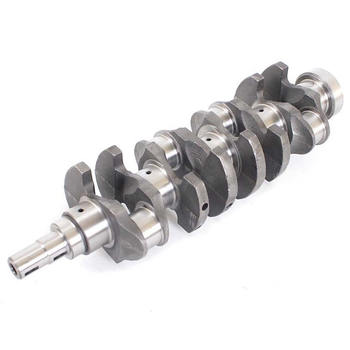
Buying a used crankshaft can be a cost-effective way to rebuild your engine, but it comes with risks. Knowing what to look for when buying a used crankshaft is crucial to avoid inheriting someone else's problems. This comprehensive guide will walk you through the essential steps of inspecting a used crankshaft, helping you make an informed decision and get the best value for your money.
Visual Inspection: The First Line of Defense
A thorough visual inspection is the first step in evaluating a used crankshaft. Start by looking for any obvious signs of damage, such as cracks, deep scoring, or excessive wear. Pay close attention to the crankshaft journals, the surfaces where the connecting rod and main bearings ride. These journals should be smooth and free of any pitting or scoring. Any discoloration, like blueing or heat marks, can indicate overheating and potential warping. Don't forget to inspect the keyway, ensuring it’s not damaged or excessively worn. Remember, a crankshaft is the backbone of your engine; even minor flaws can lead to significant issues down the road.
Measuring Journal Dimensions: Ensuring Proper Fit
After the visual inspection, accurate measurements are critical. You'll need a micrometer to measure the journal diameters. Compare these measurements to the manufacturer's specifications for your specific engine. Even slight deviations from these specifications can cause bearing clearance issues, leading to oil pressure problems and premature engine wear. Also, measure the crankshaft's overall straightness. A bent crankshaft can cause severe vibrations and ultimately engine failure. This is best done with a specialized tool called a straight edge or by a machine shop.
Checking for Cracks: A Crucial Step
Crankshaft cracks are often hidden and difficult to spot. However, they can be catastrophic if left undetected. A professional crack detection method, such as Magnafluxing or dye penetrant testing, is highly recommended. These methods can reveal even the smallest cracks that are invisible to the naked eye. While these tests might incur a small cost, they are a worthwhile investment compared to the potential expense of engine failure. Thinking of skipping this step? Ask yourself, is it worth the risk?
Understanding Crankshaft Runout: Avoiding Vibration Issues
Crankshaft runout refers to the amount the crankshaft deviates from its true center of rotation. Excessive runout can cause vibrations, leading to premature bearing wear and other engine problems. Runout should be checked both radially (perpendicular to the crankshaft axis) and axially (along the crankshaft axis). Again, a machine shop is typically best equipped to accurately measure runout. Understanding this critical aspect of crankshaft inspection ensures a smooth-running and reliable engine.
Considering the Crankshaft's History: Asking the Right Questions
Whenever possible, try to learn about the history of the used crankshaft. If buying from a salvage yard or individual seller, inquire about the engine the crankshaft came from. Was it involved in an accident? What was the engine's mileage? Knowing the engine's history can provide valuable clues about the crankshaft's condition and potential lifespan. Don’t hesitate to ask questions; the more information you have, the better equipped you'll be to make an informed decision. What are some key questions you should ask when buying a used crankshaft?
Balancing Act: Ensuring Smooth Engine Operation
A balanced crankshaft is crucial for smooth engine operation and longevity. While buying a used crankshaft, ensure it has been balanced or is ready to be balanced. An unbalanced crankshaft can lead to excessive vibrations, harming engine components and reducing performance. This is particularly important for high-performance engines. Buying a used crankshaft that requires balancing adds another step and expense, so factor that into your decision.
Decoding Crankshaft Terminology: Understanding the Lingo
Navigating the world of used engine parts can be confusing. Familiarizing yourself with common crankshaft terminology, such as "main journals," "rod journals," "thrust bearing surface," and "crank throws," can help you communicate effectively with sellers and understand inspection reports. This knowledge also empowers you to ask the right questions and assess the information provided.
The Cost Factor: Balancing Price and Quality
While cost is a significant factor when buying used parts, be wary of exceptionally low prices. Extremely cheap crankshafts may have hidden problems that could end up costing you more in the long run. Finding a reputable seller who offers a warranty or return policy is often worth the extra expense, providing peace of mind and protection against unforeseen issues. Ultimately, the goal is to find a balance between affordability and quality when buying a used crankshaft.
Where to Buy: Finding a Reliable Source
Choosing the right source for your used crankshaft is crucial. Reputable salvage yards, online marketplaces specializing in auto parts, and even engine rebuilders can be good sources. Always research the seller's reputation and look for customer reviews before making a purchase. A reliable seller will stand behind their products and provide accurate information about the crankshaft's condition.
Next Steps: Putting it All Together
Buying a used crankshaft can be a smart way to save money on your engine rebuild, but it requires careful consideration and thorough inspection. By following these guidelines, you can confidently choose a used crankshaft that meets your needs and avoids costly mistakes. Now that you're armed with this knowledge, start your search for the perfect used crankshaft! Remember to prioritize thorough inspection and choose a reputable seller. Good luck with your engine build!

 The Unseen Powerhouse: Unveili
The Unseen Powerhouse: Unveili
 Unveiling the Precision: The A
Unveiling the Precision: The A
 Navigating the World of Cranks
Navigating the World of Cranks
 The Unsung Heroes: What Makes
The Unsung Heroes: What Makes
